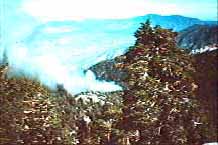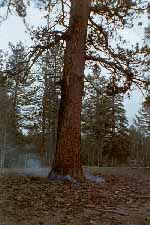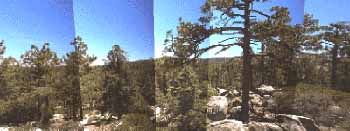|
|

© copyright 2003 Michael P.
Hamilton, Ph.D.
No Smokey

August 3, 1996:
I awoke with the acrid smell of wood smoke in my nostrils.Glancing
over at our campfire, I could see that it was completely out and that
the source of the smoke came from somewhere else. Two hundred miles
below the Mexican border and 90 miles into the Sierra San Pedro Martir
Range, Frank and I were nearly alone in this 200,000 acre national park.
Yesterday was the last day of a week of intense thunderstorms caused
by a hurricane just south of Acapulco. Heavy rains and a thousand lightning
bolts blanketed the region in a spectacular display of Mother Nature's
fury.
After preparing breakfast, we filled our day packs with lunch and gear,
adjusted our seats and chains, and headed off on mountain bikes in search
of natural fire. At more than 8,000 foot elevation, the forests of the
Sierra San Pedro Martir are remarkably similar to those within our San
Jacinto Mountains. Tall Jeffrey Pine, Sugar Pine, Incense Cedar, White
Fir and Sierra Lodgepole intermix with Canyon Live Oak, suggesting to
me any number of sites I've long studied within our local wilderness.
The mountains of Mexico are similar to our local San Jacintos because
both are part of the much larger Peninsular Mountain Range, stretching
from the north face of San Jacinto Peak, to near the tip of the Baja
California Peninsula.

a lightning strike set this sugar pine on fire
Less than one mile from camp I began to smell smoke again and in a
short distance a visible grayish haze caused by incomplete combustion
of wet wood led us directly to the source. A huge Sugar Pine standing
alone in a small meadow had been repeatedly struck by lightning and
was still on fire. Many ribbons of inch wide barkless strips spiraled
down the 150 foot tall trunk, leading into a large charcoal-lined cavity.
A person could easily stand inside the giant "cat-face," if
they were inclined to tolerate the smoke and heat. Surrounding the base
of the tree a ring of fire was gradually burning outward, consuming
the fallen needles and cones produced in the previous year by the solitary
giant. Eventually, the fire would reach the end of its fuel supply and
burn out, perhaps by late afternoon, without the aid of fire truck or
engine crew.

partial panoramic image of forest and chaparral ecotone in the
Sierra San Pedro Martir Mountains
What fascinates me about this place is that here is a forest, beautiful
in appearance, supporting healthy trees and diverse wildlife, because
fire remains a natural part of the ecosystem. The Mexican government,
for practical reasons, has not implemented a policy of putting out wild
land fires. There is no Smokey the Bear. In contrast, for the past century
our fear of fire and desire to protect the forest and our homes has
led to a policy to put out every fire that nature or man starts. The
task was simple at first, the "Bucket Brigade" fire departments
of the turn of the century could handle most wild land fires with a
single shovel-carrying hand crew, and a mule to tote water from any
nearby stream. Forests in the early 1900's were every bit as similar
to the forest I am studying in Mexico...large widely spaced trees with
very little understory besides herbs and wildflowers. Between sixty
years of logging the big trees, and a highly effective fire protection
program, our forests have become ecologically weakened. The once fire-resistant
forest is now thick and dense with younger trees and shrubs, and is
dangerously overloaded with flammable fuels.
As I pack up my gear and head back home, I wonder what can we learn
from these wonderful mountains of Mexico as we begin to face the issue
of wild fire in our own backyards. We can start by accepting that what
our fire protection policies have done for us in the past may not apply
to our forests today. As I try to imagine what the San Jacinto Mountains
were like in the year 1900, I merely open my eyes and look around, and
notice that there is not a bear in sight!

previous journal entries
|

